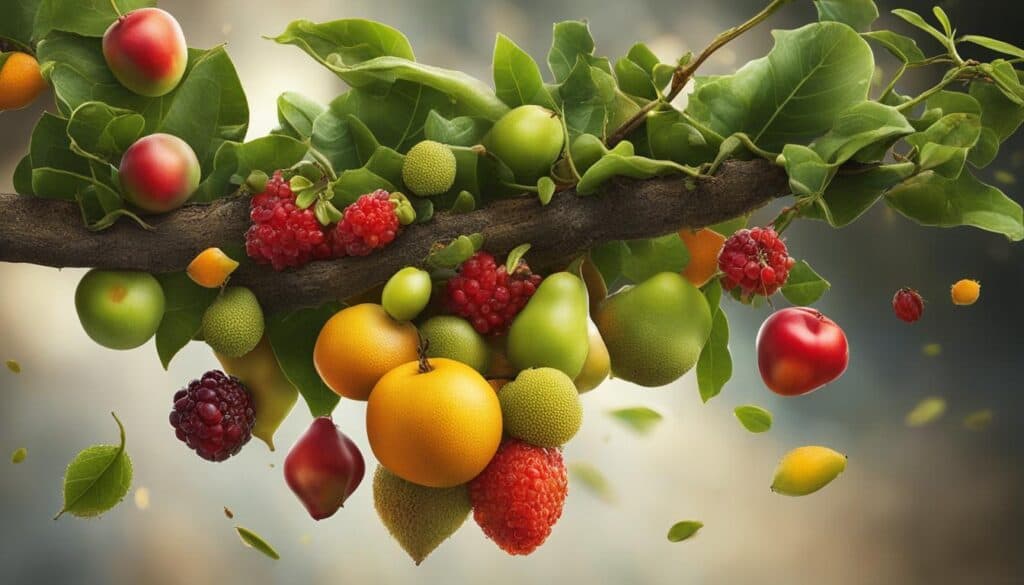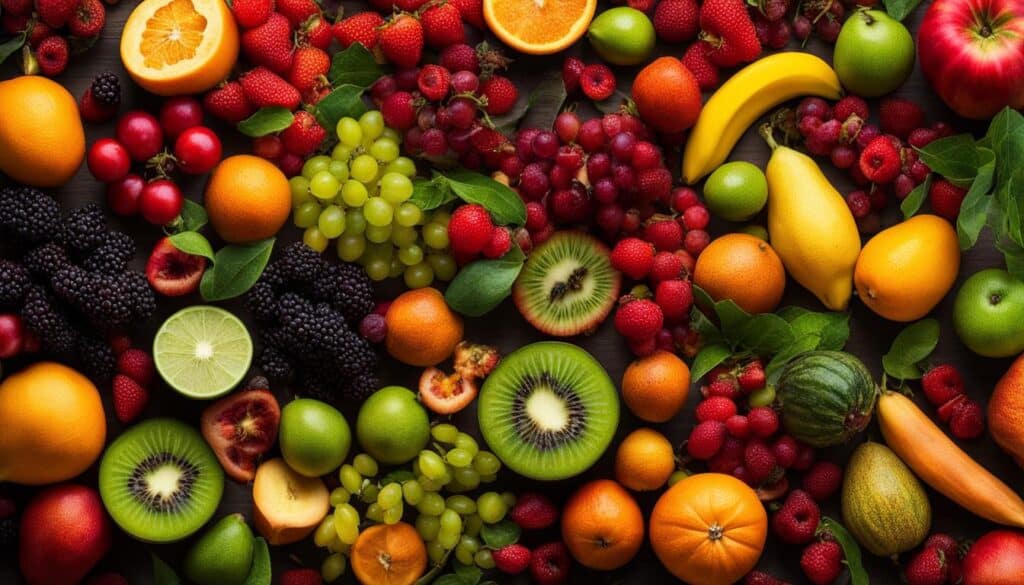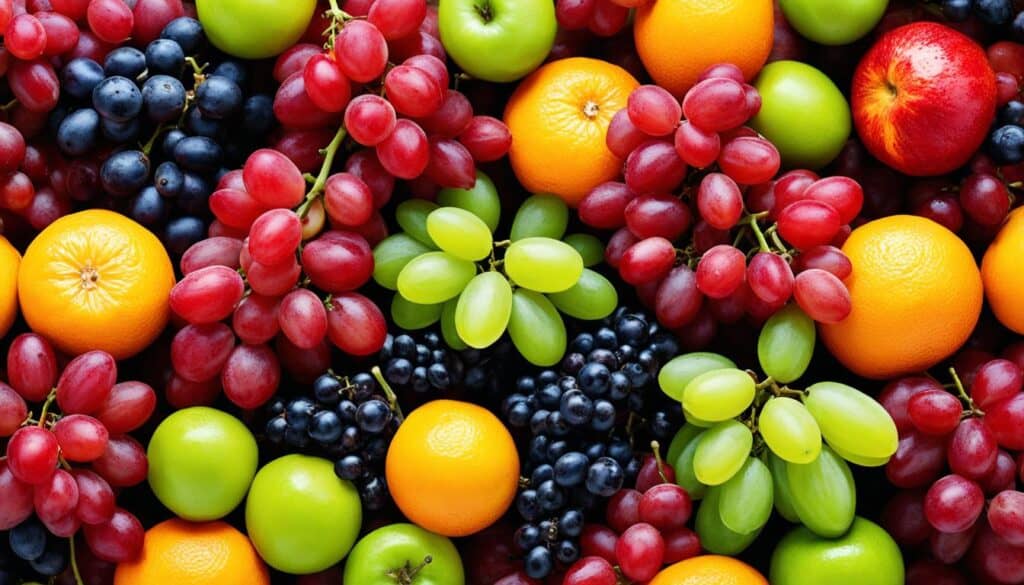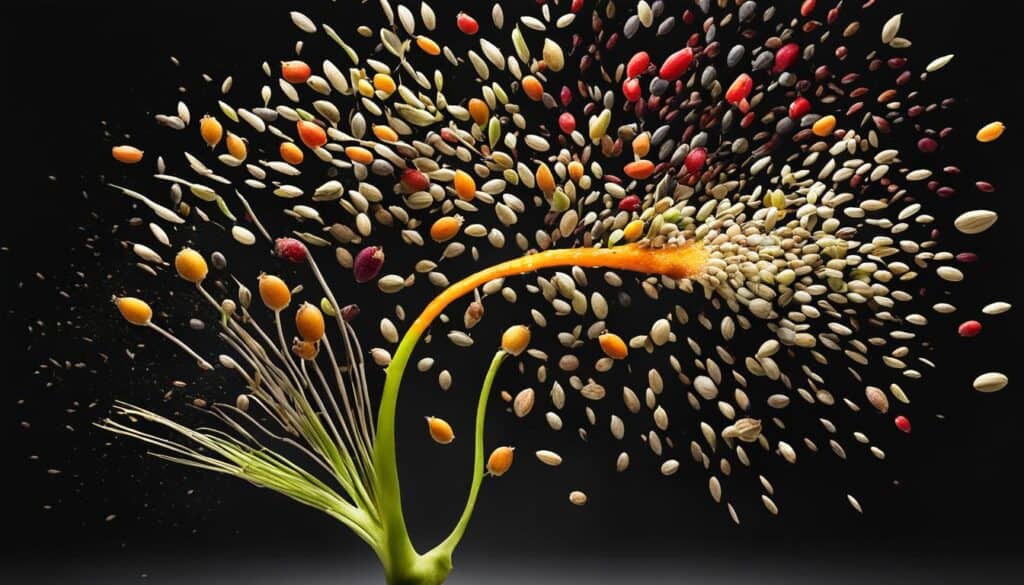Greetings! Today, I want to explore the fascinating world of fruits and seeds and shed light on their unique characteristics and functions. While they both play crucial roles in the lifecycle of plants, they have distinct differences that deserve our attention. Join me as we delve into the intriguing topic of fruit vs seed comparison, exploring their characteristics and identifying their importance in the natural world and even in our own lives.
Key Takeaways:
- Fruits and seeds have distinct characteristics and functions in the plant lifecycle.
- Fruits are the mature ovaries of flowering plants and serve to protect and disperse seeds.
- Seeds are reproductive structures that contain embryos with the potential to develop into new plants.
- Fruits are typically larger, fleshy, and edible, while seeds are smaller and encased in protective coverings.
- Both fruits and seeds are vital for plant reproduction and the survival of plant species.
What Are Fruits?
Fruits are the mature ovaries of flowering plants and contain seeds. They develop from the fertilized ovule after pollination and serve to protect and disperse the seeds. Fruits come in various forms, including fleshy fruits like apples and berries, and dry fruits like nuts and grains.
Fruits play an important role in the plant lifecycle, as they provide a protective covering for seeds and aid in their dispersal. Through a process called fruit formation, the ovary undergoes changes, such as growth and ripening, to facilitate seed development. Some fruits have a fleshy exterior, which attracts animals to consume them and disperse the enclosed seeds through their droppings. Others have a dry and hard exterior that helps protect the seeds from environmental conditions.
Fruits serve various functions in the plant kingdom. Apart from protecting the seeds, they also aid in seed dispersal. The bright colors, enticing aromas, and sweet flavors of many fruits attract animals, such as birds and mammals, who play a crucial role in carrying the seeds to new locations. By consuming the fruits, animals unknowingly assist in the dispersal process, contributing to the survival and distribution of plant species.
“Fruits are nature’s way of ensuring the survival and propagation of plant life.”
There are various types of fruits, each with its own unique characteristics. Fleshy fruits, such as apples, oranges, and strawberries, have a soft and juicy texture. They often have a high water content, making them refreshing and hydrating. Dry fruits, including nuts, grains, and pods, have a tough and rigid exterior that protects the enclosed seeds. These fruits may split open or require external factors, like heat or moisture, to release the seeds.
Fruits are not only essential for the reproduction and survival of plants but also offer numerous benefits to animals. They serve as a source of nutrition, providing vitamins, minerals, fiber, and energy. Additionally, many fruits contain antioxidants, which help protect the body against damage caused by free radicals. Including a variety of fruits in the diet is crucial for maintaining overall health and well-being.
Types of Fruits
Let’s explore some common types of fruits:
- Apples
- Oranges
- Berries (strawberries, blueberries, raspberries)
- Melons (watermelon, cantaloupe)
- Stone fruits (peaches, plums, cherries)
- Citrus fruits (lemons, limes, grapefruits)
- Tropical fruits (pineapple, mango, banana)
- Pears
- Grapes
“The variety of fruits in nature is a testament to the beauty and diversity of the plant kingdom.”
What Are Seeds?
Seeds are the reproductive structures of plants and play a vital role in their life cycle. They are formed within the ovule, which is a part of the flower’s female reproductive organ called the pistil. Inside the seeds, you will find the embryo, which has the potential to develop into a new plant. It’s incredible to think that within these tiny structures lie the blueprint for an entire plant!
Seeds are not simply small objects. They have intricate structures that are perfectly designed for their function. Each seed has a protective outer covering, known as the seed coat, which shields the delicate embryo from harm. This seed coat ensures that the embryo remains viable even under unfavorable conditions, such as extreme temperatures or drought.
Seeds are also adapted for dispersal, enabling them to move away from their parent plant and find new locations for growth. Some seeds have structures that allow them to be carried by wind or water, while others have hooks or barbs that help them cling to animals’ fur or clothes for transportation. This dispersal mechanism increases the chances of survival for the plant species, as it ensures that the seeds are spread far and wide.
There are different types of seeds, each with its own unique characteristics. One classification is based on the number of cotyledons (embryonic leaves) present in the seed. Monocotyledonous seeds, such as corn and wheat, have a single cotyledon, while dicotyledonous seeds, like beans and sunflower seeds, have two cotyledons. This distinction influences the way these seeds germinate and develop.
Seeds are truly remarkable in their ability to sustain and propagate plant life. From their protective structures to their dispersal mechanisms, they ensure the survival and proliferation of plant species. Next, we will explore the functions of fruits and seeds, uncovering the interconnectedness of these natural wonders.
| Type of Seed | Examples |
|---|---|
| Monocotyledonous Seeds | Corn, wheat, rice |
| Dicotyledonous Seeds | Beans, sunflower seeds, peas |
Key Differences Between Fruits and Seeds
When examining the characteristics of fruits and seeds, it becomes evident that they serve distinct purposes in the plant life cycle. Fruits are the mature ovaries that contain seeds, while seeds are the reproductive structures with the potential to develop into new plants.
Fruits, such as apples and berries, are typically larger in size and have a fleshy texture. They are also often colorful and edible, attracting animals for consumption. Serving as food sources, fruits play a critical role in seed dispersal as animals consume them and eventually eliminate the seeds through digestion or by carrying them to different locations.
On the other hand, seeds are smaller than fruits and enclosed in protective coverings. These coverings provide shielding and structurally support the embryonic plant within. Seeds have specialized adaptations to withstand various environmental conditions during dispersal, ensuring the survival and successful germination of the new plant. They can be dispersed through wind, water, animals, or through their own mechanisms.
“While fruits and seeds both play essential roles in the plant kingdom, their distinct characteristics contribute to the diverse strategies employed by plants for reproduction and dispersal.”
To summarize, the key differences between fruits and seeds can be highlighted as follows:
| Fruits | Seeds |
|---|---|
| Contain seeds | Have the potential to develop into new plants |
| Larger in size | Smaller in size |
| Fleshy texture | Encased in protective coverings |
| Edible and often colorful | Adapted for dispersal and survival |
Understanding these differences between fruits and seeds provides valuable insight into the fascinating mechanisms of plant reproduction and the intricate relationships between plants and their environments.
Functions of Fruits and Seeds in Plant Life
Fruits and seeds serve essential functions in the life cycle of plants, contributing to their reproduction and overall survival. Let’s explore the crucial roles these botanical marvels play in the plant kingdom.
Functions of Fruits:
- Protection: Fruits serve as protective coverings for seeds, shielding them from external factors such as mechanical damage, pathogens, and harsh environmental conditions. The thick skin or rind of fruits acts as a barrier, ensuring the safe development and germination of seeds.
- Nourishment: Fruits contain nutrients that nourish the developing embryo within the seeds. These nutrients, including sugars, proteins, vitamins, and minerals, provide essential energy and resources for the growth and development of the young plant.
- Seed Dispersal: Fruits play a crucial role in seed dispersal, helping plants colonize new areas. Some fruits have mechanisms for self-dispersal, such as the bursting of pods or the release of wind-borne seeds. Others rely on external factors like animals or water to carry and scatter the seeds to new locations.
- Pollinator Attraction: Many fruits have evolved to attract animals, particularly insects and birds, to aid in pollination. Bright colors, enticing scents, and sweet flavors entice pollinators, increasing the likelihood of successful pollination and subsequent seed production.
Functions of Seeds:
- Embryo Development: Seeds are the containers of plant embryos, which have the potential to develop into fully mature plants. The embryo, protected by the seed coat, contains all the genetic information and structures necessary to initiate growth once favorable conditions are present.
- Nutrient Storage: Seeds store essential nutrients, including carbohydrates, fats, and proteins, which act as a source of energy and nourishment for the germinating seedling. These reserves sustain the young plant until it can establish roots and begin photosynthesis.
- Genetic Dispersal: Through dispersal, seeds ensure the propagation of plant species and the spread of their genetic material. This process allows plants to colonize new habitats, increasing their survival chances and promoting biodiversity.
- Dormancy: Seeds can enter a state of dormancy, remaining viable for extended periods until favorable conditions for germination are met. This innate ability for seed dormancy ensures that plants can survive unfavorable seasons or dormant periods and maximize their chances of successful growth and reproduction.
I find it fascinating how fruits and seeds work hand in hand in the intricate dance of plant reproduction. Fruits protect, nourish, disperse, and attract, while seeds contain the potential for new life and genetic diversity.
By understanding the functions of fruits and seeds, we gain a deeper appreciation for the remarkable strategies plants have evolved to propagate and thrive in diverse environments. Now, let’s dive even deeper into the importance and uses of fruits and seeds in nature.

Importance of Fruits and Seeds in Nature
I am amazed at the immense importance of fruits and seeds in the natural world. These remarkable components play vital roles and serve multiple purposes within the ecosystem. Let’s explore the significance of fruits and seeds in more detail.
Fruits: A Bounty for All
Fruits are not only delicious treats for humans but also essential food sources for various animals. They are packed with essential nutrients such as vitamins, minerals, and antioxidants, providing nourishment and supporting overall well-being. From juicy apples and succulent berries to tropical delights like pineapples and mangoes, fruits offer a diverse range of flavors and textures that cater to different palates.
However, the importance of fruits extends far beyond their nutritional value. Fruits play a crucial role in plant reproduction and the preservation of biodiversity. Fruits attract animals with their vibrant colors, tantalizing scents, and sweet nectar. As animals feed on the fruit, they unintentionally aid in the dispersal of seeds, transporting them to new locations and facilitating the growth of new plants.
“The symbiotic relationship between fruits and seed-dispersing animals is a testament to the interconnectedness of nature.”
Seeds: Nature’s Genetic Bank
Seeds are like tiny capsules of life, packed with the potential to bring forth new plants. They ensure the survival and proliferation of plant species, contributing to the overall health and resilience of ecosystems. Seeds have protective coverings that shield them from harsh environmental conditions and predators, increasing their chances of germination and successful growth.
Seeds also play a vital role in maintaining genetic diversity within plant populations. They preserve the unique traits and characteristics of their parent plants, allowing for adaptation and evolution over time. This diversity is crucial for the long-term survival of plant species and the sustainability of ecosystems.
A Harmonious Relationship
The relationship between fruits and seeds is a harmonious one. Fruits provide nourishment and protection to seeds, while seeds ensure the perpetuation of plant species. This intricate balance contributes to the overall functioning and stability of the natural world.
| Importance of Fruits | Importance of Seeds |
|---|---|
| Provide nutrition for animals and humans | Ensure the survival and proliferation of plant species |
| Contribute to biodiversity and pollinator attraction | Preserve genetic diversity and promote evolutionary adaptation |
| Aid in seed dispersal and colonization of new areas | Protective covering enhances seed viability and germination success |
Together, the importance of fruits and seeds in nature cannot be overstated. They contribute to the balance and sustainability of ecosystems, ensuring the continued existence of countless plant species and supporting the diverse array of life on our planet.

By appreciating and valuing the vital roles that fruits and seeds play, we can promote the conservation and preservation of these precious natural resources. Embracing sustainable practices, protecting habitats, and fostering biodiversity will safeguard the future abundance and diversity of fruits and seeds for generations to come.
Health Benefits of Fruits
Fruits offer a wealth of health benefits that contribute to overall wellness and vitality. Packed with essential vitamins, minerals, antioxidants, and dietary fiber, they provide a natural boost to our bodies.
Regular fruit consumption is associated with improved digestion, enhanced immune function, and a lower risk of chronic diseases such as heart disease. Let’s explore some of the remarkable health benefits of fruits:
- Vitamins and Minerals: Fruits are rich in a variety of vitamins and minerals that support optimal health. For example, vitamin C in citrus fruits promotes a robust immune system, while potassium in bananas aids in maintaining healthy blood pressure levels.
- Antioxidants: Fruits contain powerful antioxidants that protect our bodies against free radicals, which contribute to the aging process and the development of diseases. Antioxidants help combat inflammation, reduce oxidative stress, and support cellular health.
- Dietary Fiber: Fruits are excellent sources of dietary fiber, which is crucial for a healthy digestive system. Fiber promotes regular bowel movements, helps manage weight by promoting feelings of fullness, and supports the growth of beneficial gut bacteria.
- Hydration: Many fruits have high water content, contributing to hydration and maintaining optimal fluid balance in the body. Proper hydration is essential for various bodily functions, including temperature regulation and nutrient transport.
Incorporating a variety of fruits into your daily diet can help you reap these health benefits and enjoy a delicious way to support your well-being.
So why not indulge in a vibrant fruit salad, sip on a refreshing fruit smoothie, or savor the natural sweetness of your favorite fruits as a guilt-free snack? Embrace the goodness of fruits and nourish your body from the inside out!

Nutritional Value of Seeds
Seeds are not just tiny powerhouses of life; they also offer immense nutritional value and health benefits for our bodies. Packed with healthy fats, proteins, fiber, vitamins, and minerals, seeds are a fantastic addition to a balanced diet.
Eating seeds can contribute to heart health by providing essential fatty acids, such as omega-3s. These healthy fats help reduce inflammation, lower cholesterol levels, and support overall cardiovascular well-being.
Including seeds in your diet can also improve digestion due to their high fiber content. Fiber promotes regular bowel movements, aids in relieving constipation, and supports a healthy gut microbiome, which plays a crucial role in overall digestive health.
Regulating blood sugar levels is another benefit of consuming seeds. The combination of fiber, protein, and healthy fats in seeds helps slow down the absorption of carbohydrates, preventing spikes in blood sugar and providing sustained energy levels throughout the day.
The nutritional profile of seeds varies depending on the type. For example, flaxseeds are an excellent source of omega-3 fatty acids, known for their anti-inflammatory properties and potential benefits for brain health. Chia seeds, on the other hand, are rich in fiber, which aids in digestion and promotes satiety.
Here’s a breakdown of the nutritional value of some common seeds:
| Seed | Nutritional Highlights |
|---|---|
| Flaxseeds | High in omega-3 fatty acids, fiber, and lignans |
| Chia seeds | Rich in fiber, omega-3 fatty acids, and antioxidants |
| Sunflower seeds | Good source of vitamin E, magnesium, and selenium |
| Pumpkin seeds | High in magnesium, iron, zinc, and antioxidants |
| Sesame seeds | Contain calcium, iron, and lignans |
Adding seeds to your diet is as simple as sprinkling them on salads, yogurt, or smoothies, or incorporating them into baked goods, granola, or energy bars. With their nutritional value and diverse health benefits, seeds are a versatile and delicious way to enhance your meals and support your well-being.

Culinary Uses of Fruits and Seeds
Fruits and seeds are incredibly versatile in the culinary world, providing endless possibilities for creating delicious and nutritious dishes. From desserts to savory meals, incorporating fruits and seeds adds flavor, texture, and visual appeal to your cooking. Let’s explore some of the culinary uses of fruits and seeds that can elevate your culinary creations.
Fruits: A Burst of Flavor and Sweetness
Fresh fruits are a delightful addition to any meal or snack. They can be consumed as they are, incorporated into salads for a refreshing twist, or turned into mouthwatering desserts. A bowl of mixed berries can be a treat on its own or used to top pancakes, waffles, or yogurt. Sliced apples or pears lend a natural sweetness and crunch to salads, while tropical fruits like mangoes and pineapples add a burst of bright flavors to salsas and stir-fries.
“Fresh fruits not only provide natural sweetness but also offer a wide range of vitamins, minerals, and antioxidants that are beneficial for our overall health.” – Nutrition Expert
Seeds: Crunchy and Nutrient-rich Enhancements
Seeds are not only fantastic sources of nutrition but also bring a delightful crunch and depth of flavor to your dishes. They can be sprinkled on top of salads, mixed into granola or yogurt bowls, or used as a coating for proteins like chicken or fish. Sesame seeds can be toasted and tossed into stir-fries for an added nuttiness, while pumpkin seeds make a delicious and nutritious addition to baked goods like bread or muffins.
“Incorporating different types of seeds into your diet provides a wide array of essential nutrients, such as healthy fats, protein, fiber, and various vitamins and minerals.” – Nutritionist
Recipes Worth Trying
Looking for inspiration on how to use fruits and seeds in your cooking? Consider trying these flavorful recipes:
- Fruit Salad with Honey Lime Dressing: Combine your favorite fruits, drizzle them with a tangy honey lime dressing, and enjoy a refreshing and vibrant fruit salad.
- Quinoa Salad with Toasted Almonds and Dried Cranberries: Toss cooked quinoa with toasted almonds, dried cranberries, and a light vinaigrette for a nutritious and satisfying salad.
- Chia Seed Pudding: Mix chia seeds, your choice of milk, and a sweetener like honey or maple syrup. Let it sit overnight in the refrigerator for a creamy and nutritious pudding.
- Watermelon and Feta Salad with Basil: Pair juicy watermelon with chunks of feta cheese, fresh basil leaves, and a drizzle of balsamic glaze for a delightful combination of sweet and savory flavors.
Remember, the options are endless when it comes to cooking with fruits and seeds. Let your creativity shine, explore new flavor combinations, and enjoy the culinary journey that these natural ingredients offer.
Image: A mouthwatering fruit platter showcasing a variety of colorful fruits.
Conservation and Sustainability of Fruits and Seeds
Conservation and sustainable practices are crucial in ensuring the continued abundance and diversity of fruits and seeds. By protecting natural habitats, practicing responsible seed-saving, and promoting biodiversity conservation, we contribute to the preservation of these valuable resources.
Sustainable farming methods, such as organic farming and agroforestry, play a vital role in supporting the growth and quality of fruits and seeds. These practices prioritize ecosystem health, minimize the use of harmful chemicals, and promote soil fertility, resulting in sustainable and resilient agricultural systems.
“Conservation is a state of harmony between humans and land.”
– Aldo Leopold
By adopting sustainable practices, we can ensure the long-term availability of diverse fruit and seed varieties, supporting food security and the preservation of genetic resources. Additionally, sustainable agriculture practices contribute to the protection of local ecosystems, including pollinators and other wildlife that rely on fruits and seeds for their survival.
To further emphasize the importance of conservation and sustainability, let’s take a look at some key data:
| Conservation of Fruits | Conservation of Seeds | |
|---|---|---|
| Global fruits at risk of extinction | 30% | 25% |
| Current seed bank collections | Over 1.5 million accessions | Approximately 7 million accessions |
| Percentage of seed banks practicing sustainable seed-saving | 40% | 60% |
These figures highlight the importance of focused conservation efforts and the need for sustainable practices in both fruit and seed conservation. By working together and implementing sustainable approaches, we can protect and maintain these invaluable resources for future generations.
The Future of Fruits and Seeds
The future of fruits and seeds is incredibly exciting, with advancements in production, conservation, and utilization shaping the path ahead. Researchers and agriculturists are diligently working to unlock the full potential of these essential elements of plant life, revolutionizing the way we understand and harness their benefits.
One significant area of focus is improving crop yields, ensuring a sustainable and abundant supply of fruits and seeds. Scientists are exploring innovative cultivation techniques, such as vertical farming and hydroponics, to maximize productivity while minimizing the use of resources. These advancements not only increase efficiency but also address the global demand for nutritious and accessible food sources.
Enhancing Nutritional Content
Another promising aspect of the future of fruits and seeds lies in enhancing their nutritional content. Researchers are investigating how to breed fruits and seeds that are naturally enriched with essential vitamins, minerals, and antioxidants. By leveraging genetic modification techniques, they aim to create crops that offer even greater health benefits, catering to the diverse and evolving dietary needs of consumers.
Preserving Genetic Diversity and Cultural Heritage
A crucial endeavor for the future is the preservation of heirloom and indigenous fruit and seed varieties. These traditional varieties are not only valuable for their remarkable flavors and unique characteristics but also for their preservation of genetic diversity. Efforts are underway to conserve these varieties, ensuring the continuation of cultural heritage and the safeguarding of valuable genetic resources.
| Advancements | Benefits |
|---|---|
| Improved crop yields through innovative cultivation techniques | Increased agricultural productivity and food security |
| Enhanced nutritional content through genetic modification | Healthier and more nutrient-rich food options |
| Preservation of heirloom and indigenous varieties | Conservation of genetic diversity and cultural heritage |
With these advancements in fruit and seed production, the future holds immense potential for healthier and more sustainable food systems. It is a testament to our collective commitment to nurturing and harnessing the gifts of nature responsibly.
Conclusion
Fruits and seeds are remarkable wonders of nature, each possessing unique characteristics and playing vital roles in plant reproduction. The differences between fruits and seeds, their functions, and their significance in both the natural world and human health are truly fascinating. By gaining a deeper understanding of these botanical treasures, we can develop a greater appreciation for their value and utilize them responsibly.
Embracing sustainable practices and promoting biodiversity conservation are essential in securing a prosperous future. By doing so, we can ensure the abundance and availability of fruits and seeds for generations to come. The responsible cultivation and preservation of these gifts from the plant kingdom not only benefit our own well-being but also contribute to the overall health and resilience of our ecosystems.
Let us continue to celebrate the marvels of fruits and seeds, their diverse flavors, nutritional benefits, and their contributions to our culinary experiences. At the same time, let us remember the critical role they play in nourishing the animal kingdom and maintaining the delicate balance of our natural world. Through these collective efforts, we can create a sustainable and fruitful future that honors the gifts of nature.
FAQ
What are the differences between fruits and seeds?
Fruits are the mature ovaries of flowering plants that contain seeds, while seeds are the reproductive structures with the potential to develop into new plants. Fruits are typically larger, fleshy, and edible, serving as food sources for animals. Seeds, on the other hand, are smaller and encased in protective coverings.
What are the functions of fruits and seeds in plant life?
Fruits protect and nourish seeds, aid in seed dispersal, and attract animals for pollination. Seeds contain the embryo and necessary nutrients for plant development, facilitating the spread of genetic material to new locations.
What is the importance of fruits and seeds in nature?
Fruits provide food sources for animals, including humans, and contribute to biodiversity by attracting pollinators and seed dispersers. Seeds ensure the survival and proliferation of plant species, contributing to the overall health and resilience of ecosystems.
What are the health benefits of fruits?
Fruits are rich in vitamins, minerals, antioxidants, and dietary fiber. Regular fruit consumption is associated with improved digestion, enhanced immune function, and lower risk of heart disease.
What is the nutritional value of seeds?
Seeds are excellent sources of healthy fats, proteins, fiber, vitamins, and minerals. Consuming seeds can support heart health, improve digestion, regulate blood sugar levels, and provide essential nutrients for overall well-being.
How are fruits and seeds used in cooking?
Fruits are enjoyed fresh, juiced, or used as ingredients in various dishes, desserts, and beverages. Seeds can be incorporated into recipes for added flavor, texture, and nutritional value. They can be toasted, ground, or used as toppings in salads, baked goods, smoothies, and spreads.
What can be done to conserve and sustain fruits and seeds?
Conservation of natural habitats, responsible seed-saving practices, and promoting biodiversity conservation contribute to the preservation of fruits and seeds. Sustainable farming methods, such as organic farming and agroforestry, also play a crucial role in supporting the growth and quality of fruits and seeds.
What does the future hold for fruits and seeds?
Advancements in production, conservation, and utilization are being pursued to improve crop yields, enhance nutritional content, and develop sustainable agricultural practices. Efforts are also underway to preserve heirloom and indigenous fruit and seed varieties, ensuring the preservation of genetic diversity and cultural heritage.





Leave a Reply